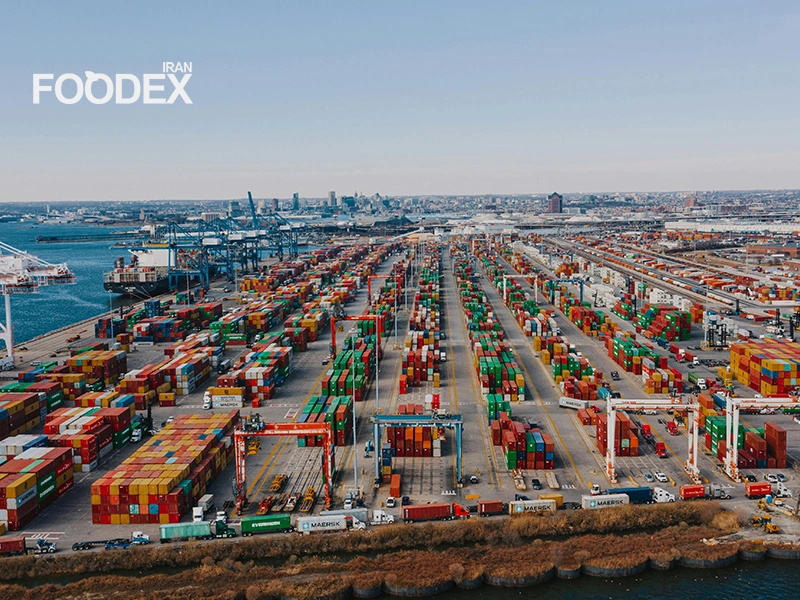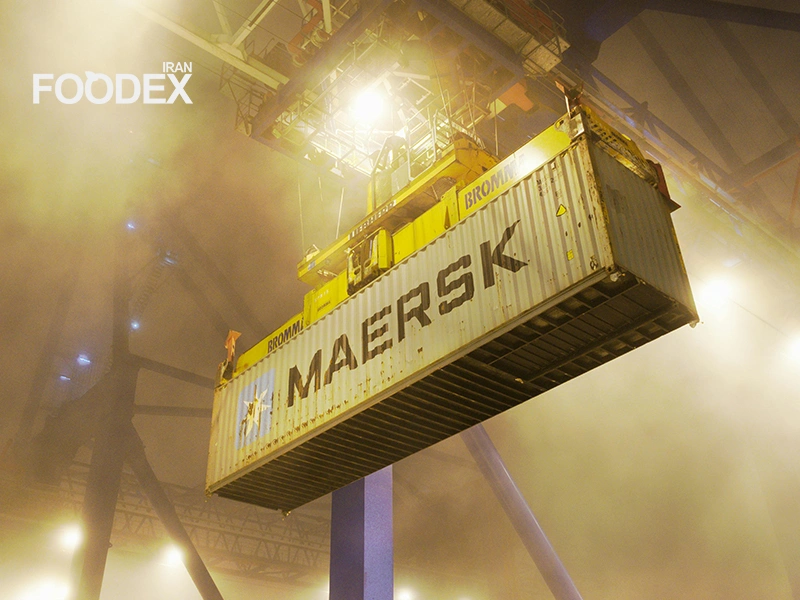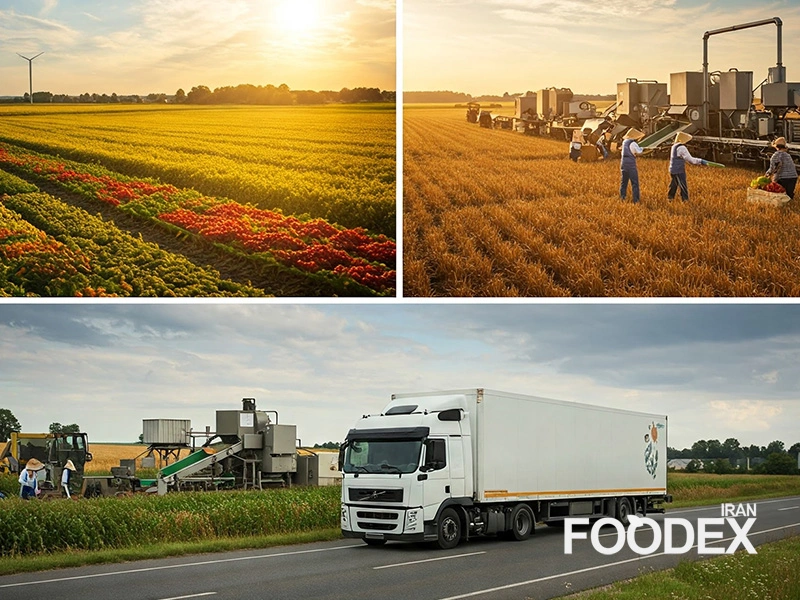A supply chain operates beyond basic transportation because it functions as a tactical platform that has developed continually since ancient times until current times. Your question likely asks how a basic procedure evolved into becoming one of the critical elements of modern commercial operations. Supply chains have existed since humans initiated exchanges in their trading activities. History has brought noteworthy changes in supply chains, which developed them into their contemporary complicated strategic format. The development of supply chains stretches backward from the past to the modern era, and we will explore this chronological expansion in this Foodex Iran Magazine article.
1. Ancient Era: The Beginning of Trade and Early Logistics (Before 1000 BCE)
The people from early civilizations typically obtained all their necessary products within their community boundaries. When cultures spread across greater regions, the first elements of modern supply chains appeared. Different historical civilizations maintained limited basic approaches to transport their goods. The ancient Egyptian construction of the pyramids involved a system where pyramid materials were collected from scattered sources before being carried by water and land vehicles. China pioneered extensive global trade relations with its Silk Road system that operated from 206 BCE until the beginning of the 14th century CE.
2. The Middle Ages: The Formation of Organized Trade (500 – 1500 CE)
As Rome and the Mongols established vast empires, new trade systems and supply chains developed into more complex and organized networks. The emerging trade networks allowed different geographic areas to connect effectively. Warehousing operations developed advanced storage capabilities at this time. The advanced storage systems controlled by the Roman Empire managed different requirements, including military stores and food stockpiles. Financial systems and banking institutions implemented checks and bills of exchange as payment tools, diminishing the need to transport actual cash.
3. The Industrial Revolution: The Rise of Mass Production and the Modern Supply Chain (1750 – 1900 CE)
The Industrial Revolution introduced dramatic changes through which goods could be manufactured and shipped on a large scale. The production methods radically transformed to focus on mass production following advancements in machinery and new manufacturing technologies. The modifications produced dramatic consequences on supply chain management. The construction of railroads and the installation of steamships produced a remarkable acceleration in international goods transportation speed. The achievement of modern warehousing systems allowed businesses to improve their storage capacity and determine optimal product distribution times. Companies started looking for new transportation strategies that enabled faster and more economical delivery of goods because of the evolving logistics management system.
4. Early 20th Century: World Wars and Logistical Advancements (1900 – 1950 CE)
The structure of supply chains underwent significant changes due to World Wars I and II. Modern armies demanded fast and vast movement operations for their equipment and goods supply needs. Due to this critical requirement, multiple innovative systems for moving and storing goods have emerged in Europe and America. The military logistics framework was created at this moment in history. The business community adopted this supply chain optimization concept, which has become essential in enhancing process management.
5. Late 20th Century: Digitalization and Supply Chain Optimization (1950 – 2000 CE)
Organizations used new technological advancements developed between 1950 and 1990 to improve inventory oversight and forecasting abilities. New supply chain models designed in the 1950s enabled organizations to improve their inventory control and market prediction. During the 1960s, Material Requirements Planning (MRP) emerged as a system that allows producers to execute detailed production planning. The market received integrated logistics systems during the 1980s, allowing businesses to lower their storage costs and transportation expenses. During the 1990s, businesses received advanced software solutions, which included Enterprise Resource Planning (ERP) systems that provided unified system management for their complete supply chain operation.
The Role of Third-Party Logistics (3PL) in the Food Supply Chain
Learn More6. The 21st Century: Globalization and Technological Advancements in Supply Chains (2000 – Present)
The Structure of worldwide supply chains underwent radical transformation because of globalization and new technological developments when the 21st century began. Information technology and digital communication advances facilitated the complete interconnection of supply chains for maximum operational complexity and efficiency.
Information Technology and Automation in Supply Chains
Advanced automated systems and innovative software solutions took over supply chain optimization activities in 2000. Companies use advanced ERP systems, barcode scanners, RFID technologies, and IoT capabilities to achieve better inventory tracking and enhanced distribution and transportation services.
Big Data Analytics and Artificial Intelligence
Following the last ten years, artificial intelligence and big data analytics have proven essential to generating data-driven supply chain predictions, which result in improved decision-making. Modern technologies enable organizations to improve inventory distribution efficiency by optimizing delivery processes so they need less stock while enhancing their sales predictions. Businesses use contemporary machine learning processing to examine market data, which helps them make better strategic decisions.
Digital Transformation and E-Commerce
E-commerce achievements include a remarkable expansion throughout COVID-19 that has raised fundamental demands for efficient delivery operations. The sudden industry change required businesses to digitize their logistics operations for better customer need fulfillment quickly.
Companies benefit from Transportation Management Systems (TMS) and Warehouse Management Systems (WMS) to achieve operational efficiency through modern automation of transportation and warehousing activities.
Sustainable Supply Chains and Corporate Responsibility
Modern industry evaluates both environmental consequences and social effects that supply chains generate. Modern companies achieve economic efficiency alongside their goal to decrease their ecological impact. Organizations work to implement renewable power sources as they combine waste reduction and supply chain worker protection activities to develop sustainable operations.
International Trade and Global Supply Chain Challenges
The recent global trade disruptions, such as trade wars, political crises, and market fluctuations, have compelled companies to enhance the flexibility of their supply chains. Various businesses now explore multiple sourcing approaches to cut supply chain vulnerabilities while eliminating their concentration on particular geographic areas.
Comparison of Supply Chains Across Different Eras
| Key Supply Chain Characteristics | Historical Period |
| Basic transportation methods, barter trade, early trade routes such as the Silk Road; goods were transported manually or using pack animals. | Ancient Era |
| Formation of trade networks, international commerce, improved banking and warehousing systems, enhanced cross-border trade. | Middle Ages |
| Mass production, advancements in logistics, introduction of machinery for transportation and manufacturing, improved production efficiency. | Industrial Revolution |
| Military logistics, impact of world wars on supply chain distribution, increased reliance on railways and motor vehicles. | Early 20th Century |
| Introduction of supply chain management systems such as MRP (Material Requirements Planning) and ERP (Enterprise Resource Planning), improved inventory and distribution management. | Late 20th Century |
| Use of artificial intelligence, blockchain, electronic logistics, sustainability and green transportation, advancements in robotics and automation. | 21st Century |
The Future of Supply Chains: What Lies Ahead?
New advancements and technological developments will lead to increasingly advanced yet efficient supply chain operations. This text examines the main developing trends alongside innovative practices that will determine forthcoming supply chain operations.
AI-Driven Supply Chains
Computational systems of artificial intelligence (AI) and machine learning activities will drive substantial improvements in inventory management practices and distribution of goods. Real-time data processing through predictive algorithms helps businesses create better estimates of anticipated consumer demand to plan transportation routes efficiently.
Increased Use of Robotics and Automation
Supply chain management will depend significantly on robotics and automation technology soon after the present day. The intelligent warehouse system Amazon operates shows robots moving goods through automated precision. Implementing computerized systems will maximize warehouse operational effectiveness through reduced human mistakes and reduced personnel expenses.
Green and Sustainable Transportation
The industry that manages supply chains adopts renewable energy and environmentally friendly transport methods as its primary focus. Electric vehicles, low-energy air and sea freight, and alternative fuels must be fully adopted to create sustainable logistics operations.
3D Printing in Supply Chains
3D printing technologies represent one of the most revolutionary products, creating possibilities for onsite local manufacturing and allowing nations to cut ties with foreign suppliers. This technology will maximize inventory levels while reducing transportation expenses and providing brand-new possibilities for small-scale operations across various sectors.
Modern Supply Chain: Key Differences Between Traditional Trade and Supermarkets
Learn MoreConclusion: The Critical Role of Supply Chains in the Modern World
Organizations derive their global market competitive advantage from supply chains, which have evolved into essential business growth. The supply chain field has transformed continuously throughout the history of mass production, from the Industrial Revolution to present-day digital supply chains. Efficient supply chain management significantly impacts business success because customers demand speed and precision in their delivery services.
Frequently Asked Questions About the History of Supply Chains
What is a supply chain, and why is it important?
A supply chain involves all processes which transform raw materials into finished products before their delivery to customers and why such systems remain vital.
How do technologies help improve the supply chain?
The supply chain receives enhanced accuracy and speed along with increased efficiency through new technologies including Internet of Things (IoT), big data, and ERP systems. The technologies provide real-time access to specific data about inventory and transportation functionalities alongside all other organizational processes.
Why is a sustainable supply chain important?
A sustainable supply chain system works to minimize environmental destruction while it ensures better working circumstances and maintains ethical practices. The present consumer trend demonstrates increased concern for both environmental issues and social impacts which causes people to select businesses that demonstrate authentic corporate social responsibility.
Ehsan Allahverdi
Executive Manager of Foodex Iran
Marketing Consultant for Leading Food & Beverage Brands
website | linkedin

























